“What do you think this is?”
Joseph, our guide, holds a small, green object in his hand, about the size of a grape, but clearly much firmer. I’ve never seen anything quite like it before, but given that we’re at the recently relocated Satok Market, one of Kuching’s most famous food markets, I’m reasonably certain the proffered item is at least edible. But whether it’s a fruit or a vegetable (it’s probably not an animal…), I have no idea. And given Joseph’s mischievous grin that is very nearly a smirk, it’s clear he doesn’t expect anyone to correctly answer his query.
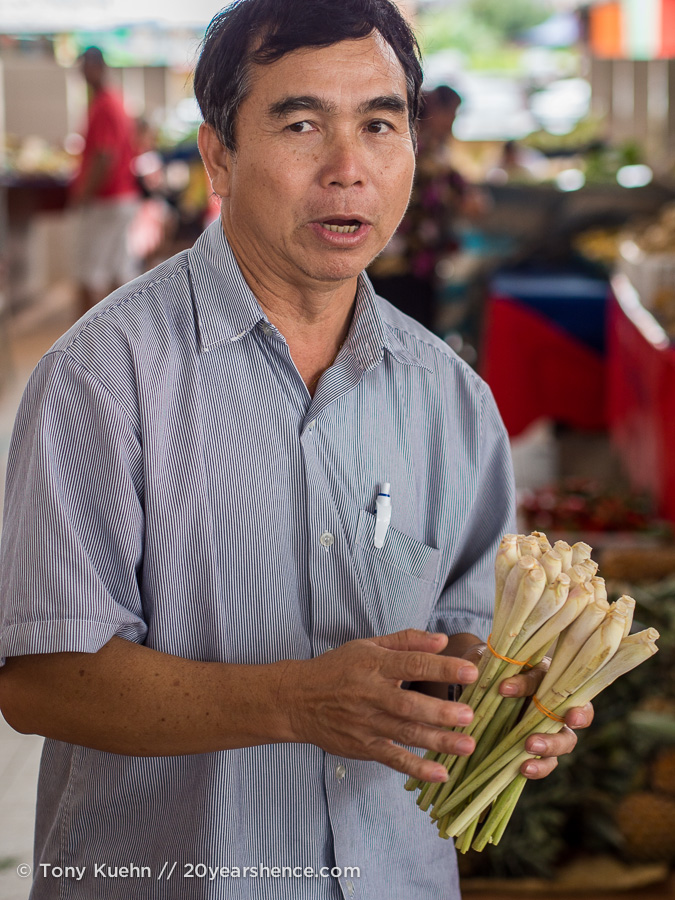
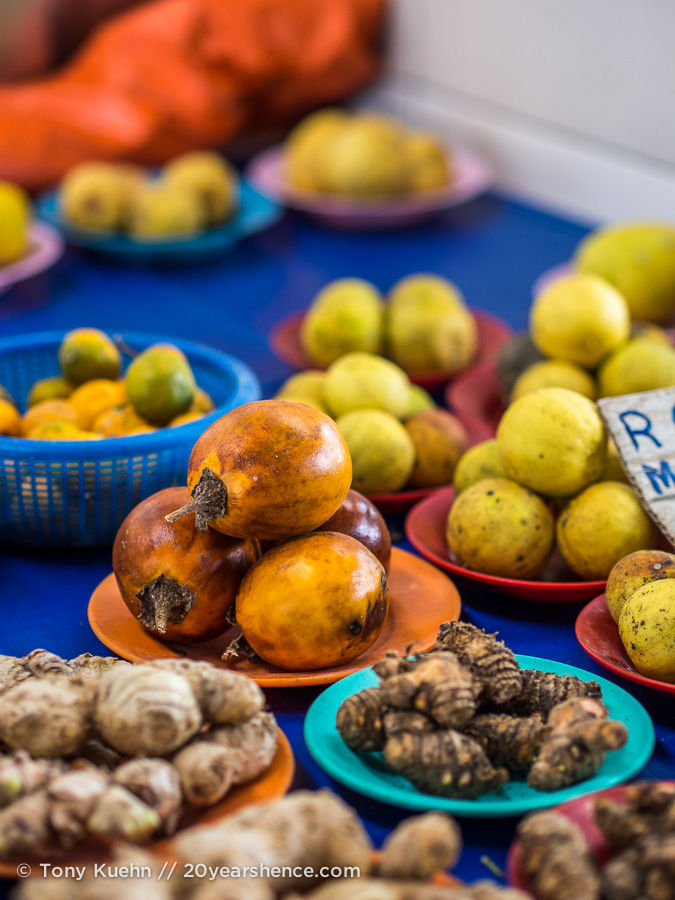
We shuffle our feet and mumble various plant names, before Joseph puts us out of our misery.
“It’s an eggplant!” he crows ecstatically, delighted that such a commonplace vegetable has so thoroughly befuddled a group of adults.
The thing is, there are a lot of exotic edibles on display at this market, and even familiar veggies we know well camouflage themselves in unfamiliar guises. Joseph patiently walks us through the market, pointing out all the weird and wonderful local produce on display, stumping us repeatedly. From bundles of tightly coiled fiddlehead ferns to delicate pink bouquets of beautiful banana hearts to fresh green peppercorns still on the stem to fragrant beans that are actually fruits that smell like garlic and cheese, the tables we pass are laden with ingredients that confound our senses. Over and over again, we misidentify eggplant, as we never dreamed they could come in so many different shapes, sizes and colors. We eventually strike upon the strategy of simply guessing eggplant whenever Joseph shows us something new, but catching wise to our tactic, he throws in the occasional tomato or plum just to keep us on our toes.
Truthfully, I had not gone into this market tour—the start of an afternoon spent with Bumbu Cooking Class—with very high expectations. Considering myself a pretty savvy cook, I didn’t anticipate that I’d learn very much from the tour, so I am delighted to find it not just fun but really informative. Though Tony & I had undoubtedly spotted many of the ingredients Joseph shows us on previous independent jaunts through the local markets here in Asia, we almost certainly glossed over most of what we saw, either ignoring the things we couldn’t readily identify, or (as in the case of the many chameleon-like eggplants we are shown) incorrectly categorizing what we saw. With Joseph at our side, we swiftly realize that the local market is a treasure trove stocked with riches that far outstrip our limited ingredient knowledge… just as it was in Kota Kinabalu, it is here that we witness the flow of life in Kuching, the shoppers and sellers that surround us completely in their element. As we move from stall to stall, picking up ingredients for the dishes we’ll make—mounds of freshly grated coconut, creamy dollops of blended curry pastes—we discover that every thing we purchase has a story behind it and some sort of personal connection. Unlike the big box supermarkets back home, everything we buy here seems to be freshly plucked from the earth or scooped from the sea, a celebration of how bountiful nature can be.
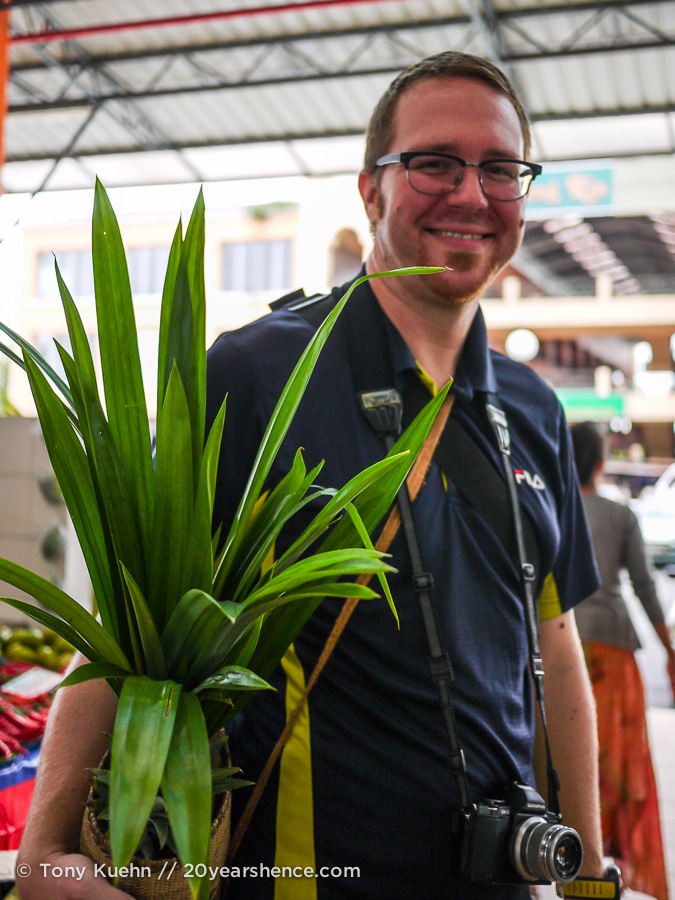
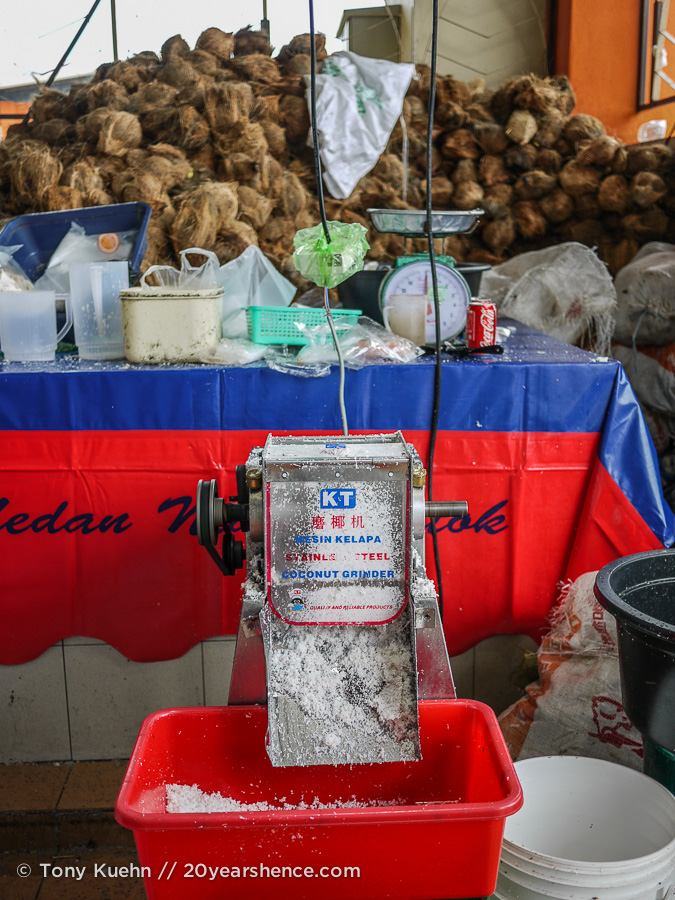
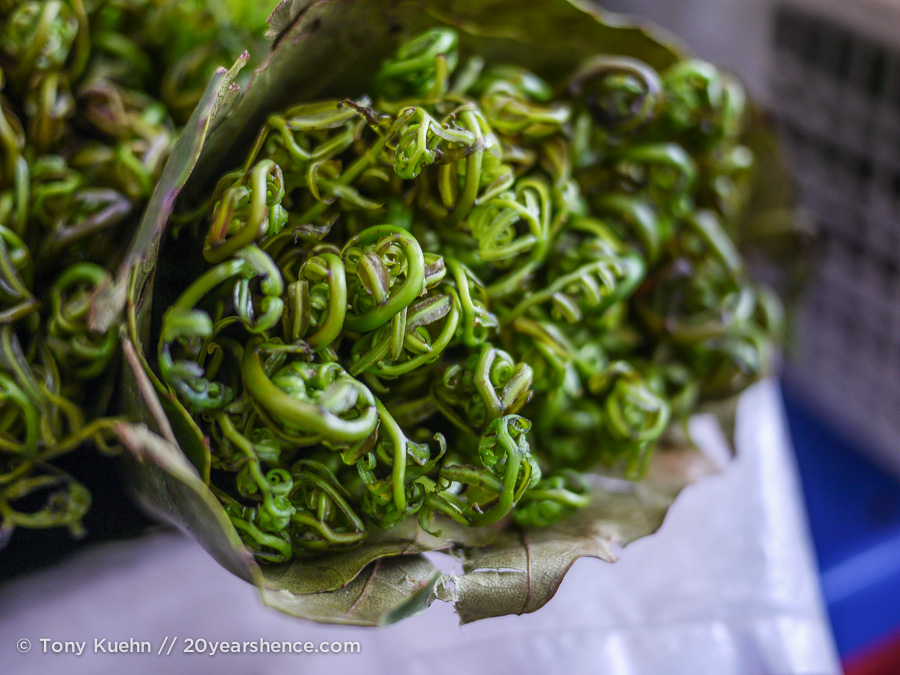
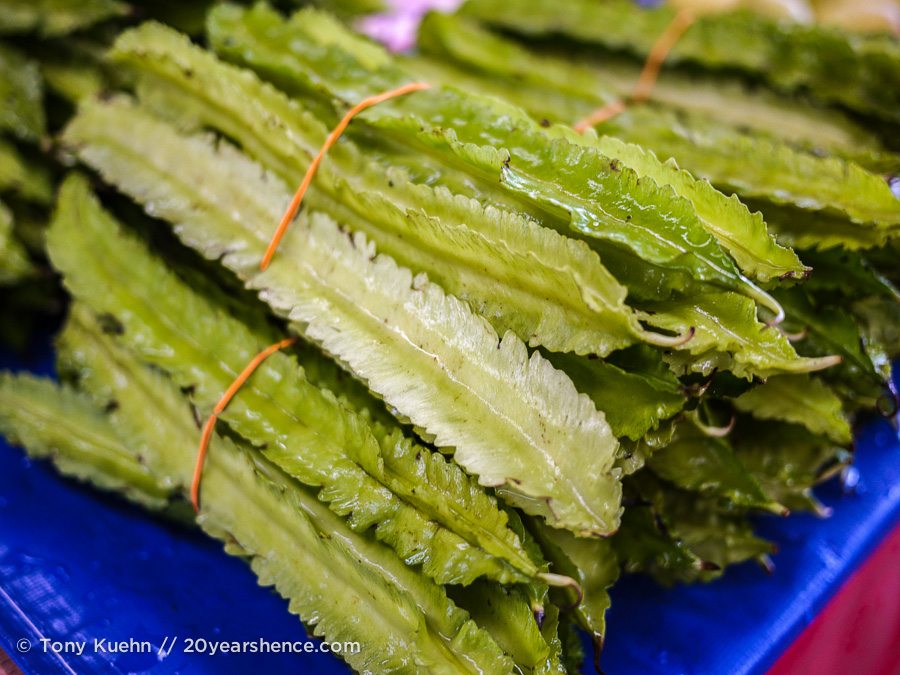
Bags filled with vegetables and fresh herbs, we pile into a mini van and head back to the building housing the Bumbu Cooking Class. Initially I’m disappointed to learn that the day’s menu will consist of chicken curry, a stir fried fiddlehead salad, and a traditional dessert; when I signed up for the class, there hadn’t been a menu posted so I was prepared for a surprise. Still, I’ve made a lot of chicken curries in my day and I was hoping for something a little more exotic, a little more interesting, and a little more challenging. I was hoping for dishes that, should I ever find myself with access to a kitchen again, that I could whip out with pride, dazzling dinner guests with an authentic meal straight from Borneo. I doubt that chicken curry will knock anyone’s socks off.

What’s done is done, however, and we’ve already paid for the class, so I roll up my sleeves and prepare to make the best chicken curry of my life. What I always seem to forget is that simple dishes like this are ones that hinge upon every step being executed perfectly, and I soon feel like I’m not just learning how to cook this dish, but am learning the building blocks of cooking that will make any dish better. As my favorite off-his-rocker professional chef, Marco Pierre White, is prone to reminding cooks in his kitchen, “Perfection is a lot of little things done well.”
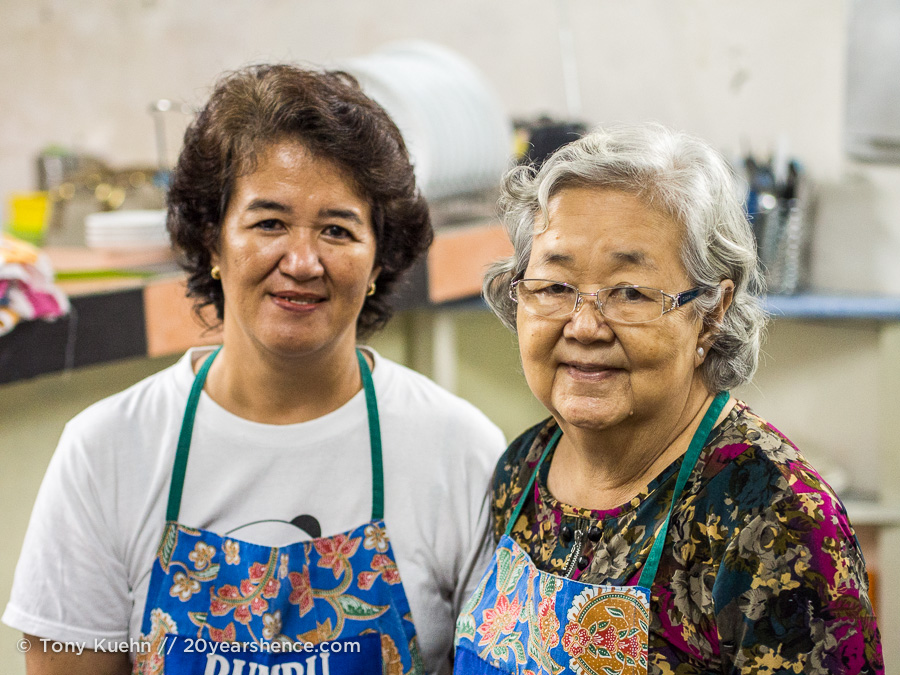
And, of course, the brilliant thing about making a chicken curry, is that there is no universally accepted version of the dish: just as Indian curries differ from Thai curries (and there is more than one style of curry within each country), a Borneo chicken curry is its own thing too. Every chef has his or her own unique recipe, and at Bumbu, the ladies running the class, a mother-daughter duo, teach us a version that has been passed down through countless generations. We learn the secret to potatoes that maintain their structural integrity (par-cook them by frying them first before adding them to the curry), how to get the most flavorful chicken that falls off the bone rather than bland, rubbery pieces (only add small amounts of water to the gravy at a time while the chicken is simmering because this will help the spices penetrate the meat in a way that isn’t possible if you dump all of your water in from the start), and that when using coconut milk or cream in a curry it should only be drizzled in right at the end to prevent curdling. Though I might have worried initially about being given a boring dish, the end result is one of the richest, most flavorful curries either Tony or I have ever made.
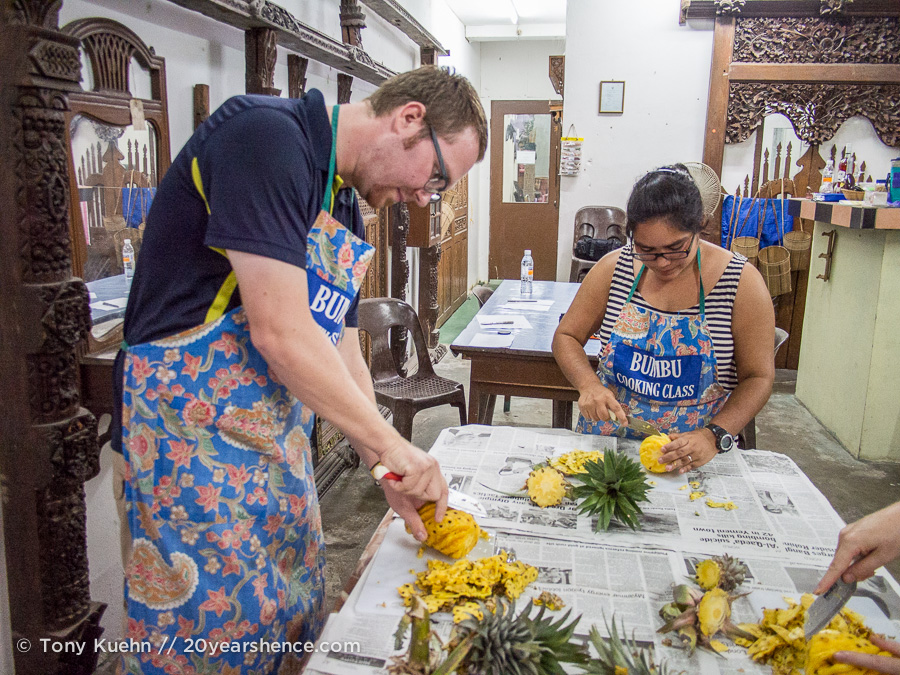

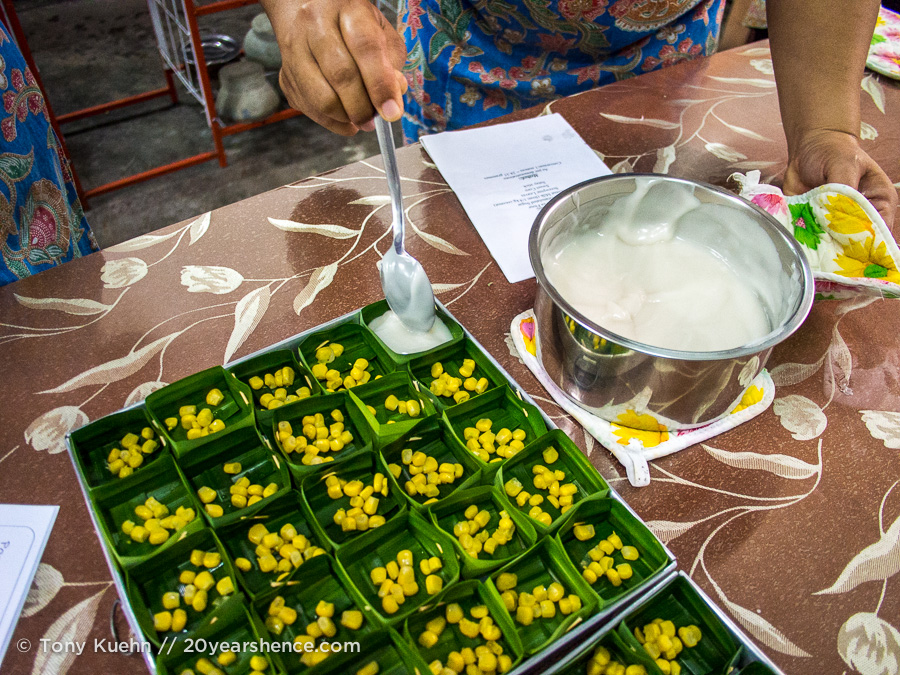
While our curry is stewing away, we turn our attention to dessert preparation, learning how to slice up pineapples in a fancy, though extremely laborious, fashion. We strip away the prickly outer skin and swivel our knives in a swirling pattern so that the final slices looked like delicate little pinwheels. Then we turn our attention to a traditional dessert called kuih tako that is a bit like a coconut pudding crossed with a mousse, sprinkled with kernels of corn for sweetness. Though I’m normally all thumbs when it comes to anything with a whiff of arts and crafts about it, I dutifully cut up pandan leaves and fold them into sturdy little molds in which the dessert will set, and am vindicated when I successfully assemble as many of the boxes as everyone else in the group.

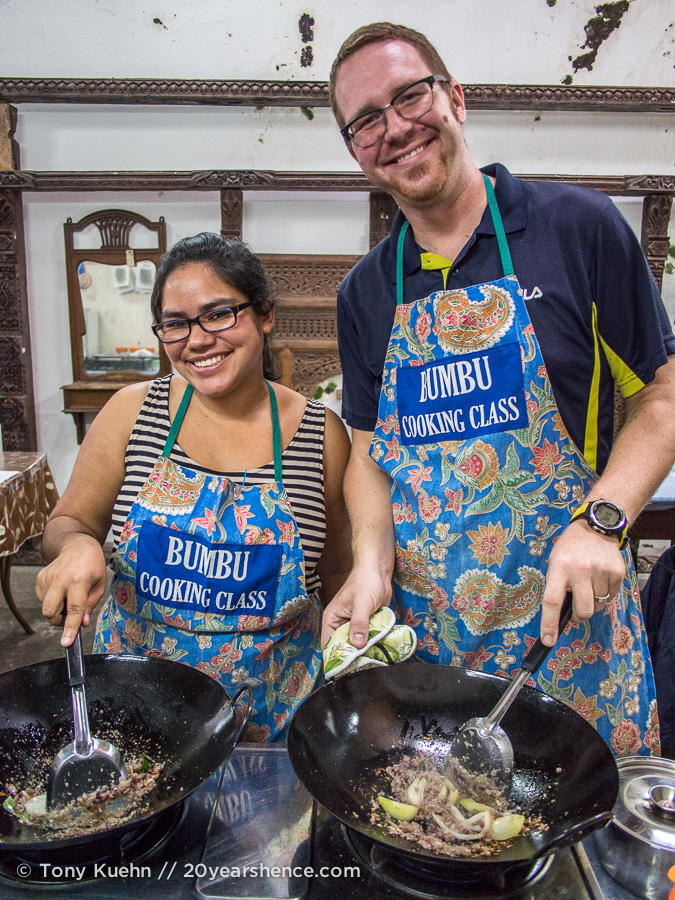
Our final dish is fiddlehead ferns sautéed with sambal. Despite our teachers’ earnest urgings, I only add in the tiniest pinch of dried shrimp to the ingredients to be smashed in my mortar and outright refuse to add in any of the fermented and incredibly pungent shrimp paste known as belican, because I find its funky fish flavors far too overpowering for my seafood-sensitive palate. Although I get many a look of consternation thrown my way and our teacher laments that the dish won’t taste quite right without, I soldier on and am immensely pleased with my belican-free version of the dish.
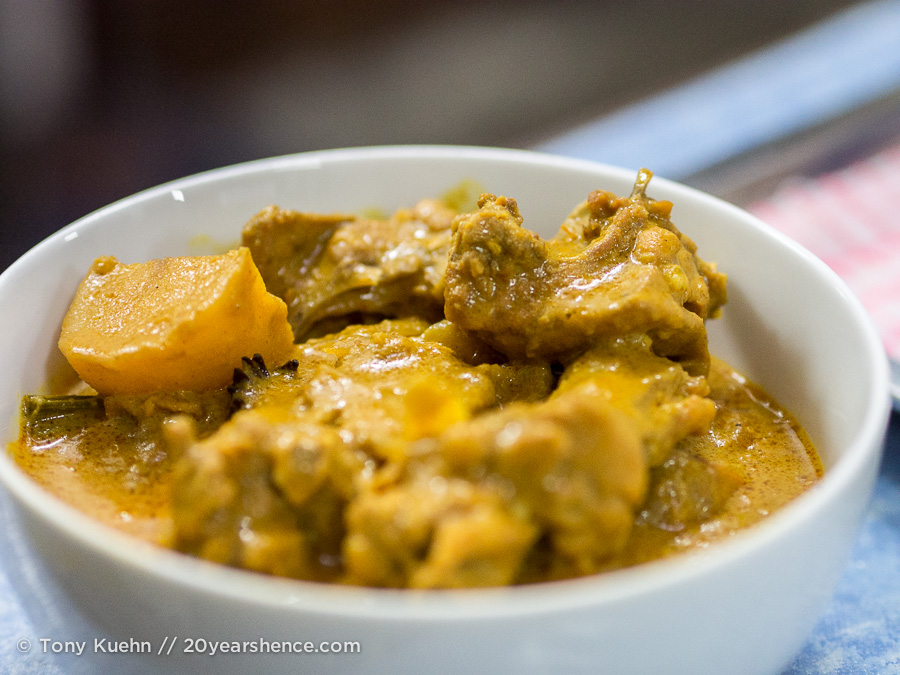
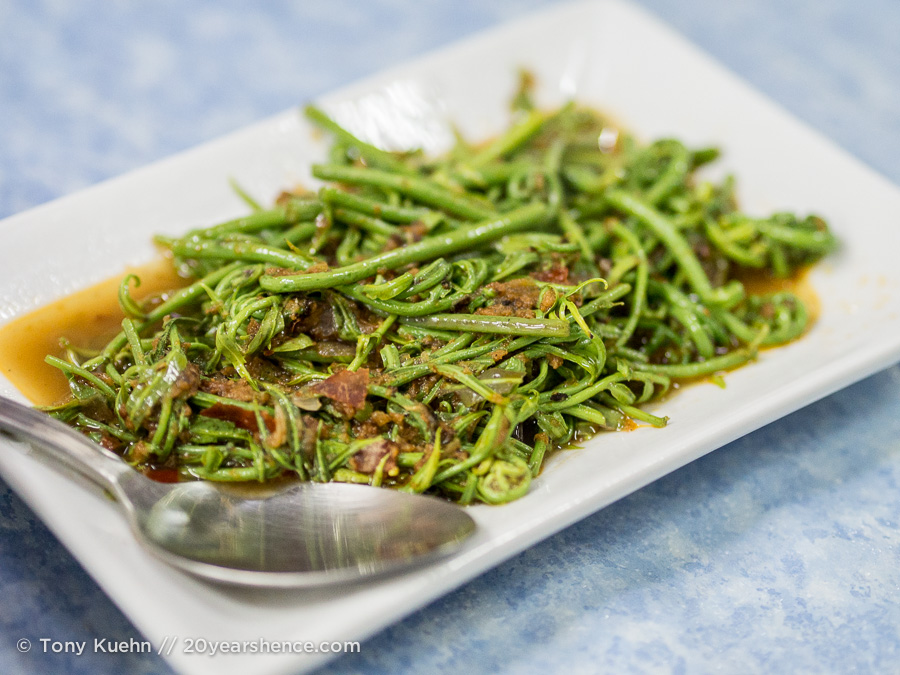
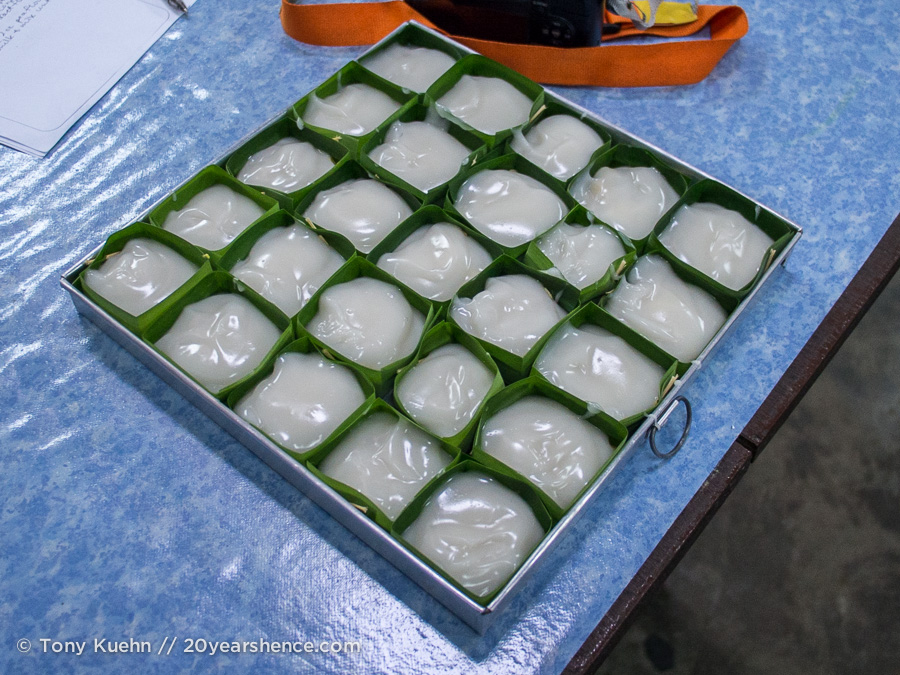
When all the dishes are completed, we sit down and feast until our bellies bloat and we are all slightly uncomfortable. As we head out into the late afternoon, a slight drizzle beginning to fall from the gray skies above, I wonder if I’ll ever feel hungry again. The next day at noon, when my tummy finally starts to rumble with hunger, I decide to try a curry for lunch… only to immediately decide that the one I made was infinitely superior. I don’t try the dish again until weeks later when we’ve hit Thailand. I suppose that’s the Catch-22 of attending a good cooking class, and if that’s not a sign that Bumbu did its job well, then I’m not sure what is.
We paid for our cooking class with Bumbu in its entirety and did not receive any kind of kickback or special treatment for writing about our experiences.
Tell us: Have you ever taken a cooking class while traveling? What’s the best dish you learned?
Oh you made my day!!! I want to spend the rest of my life wandering the markets around the world!!! Great pictures. I’ll have to try that cooking class next time I’m Vietnam!
We did a wonderful cooking class in Vietnam, but unfortunately this one wasn’t it! This one was actually in Kuching, Malaysia (in Borneo). I’ll be sure to write about our great cooking class (complete with another market tour) in HCMC, though, so just you wait!
lol.. oh dear Steph.. can you tell I was not slowing down and living in the moment (apparently everyone’s 2014 mantra!) when I commented!? Regardless, did love the post and can’t wait to hear about more cooking classes in future posts!
all this food confuses me but i want to taste it
Even the chicken curry confused you?!? I find that hard to believe! 😉
I LOVE taking cooking classes. I love that we can tweak it to our tastes and that, almost always, we can look back on our versions and think they are ever-so-slightly superior! I hope we can find some affordable ones in our sojourn to Europe this spring!
I agree completely. I really enjoy cooking but I often found myself feeling like my home-cooked meals were never “restaurant quality”. Now I see that making an investment in a cooking class can be totally worth it as not only do you learn to make restaurant quality dishes, but they can actually be even better! I’d love to take some classes when we hit Europe, but I worry they’ll break the bank. Still, it’s hard to think of any other activity that offers better value on a trip.
Gorgeous, gorgeous food photography! Borneo has much more going in the food department than I ever imagined. Terrific post!
Thanks, Lesley! I have to admit, we weren’t actually that bowled over by most of the food we had while dining out while in Borneo, but on the occasions where we were able to step into the kitchen or eat in the homes of locals, the food really was remarkable. I’m so glad we decided to take this class and get a real taste of Borneo.
Shushma’s cooking class in Udaipur, India!! I learnt how to make delicious dhal, butter paneer masala and perfect roti 🙂 it was actually one of the best things I’ve done while travelling- I was a bit skeptical when my travelling buddy asked me along, but now I’m glad I went! I want to do a Thai cooking class somewhere next (ie- somewhere in Thailand
I would LOVE to take a cooking class (or two…) in India one day. I adore Indian food but it never tastes quite right whenever I’ve made it at home (except I do make a mean chicken tikka masala), so it’s definitely a place where I’ll make classes a priority. I also really want to visit Udaipur, so thank you for the recommendation!
I totally agree with you on the fermented shrimp paste Steph, the less the better I think. And as you say that different countries have different versions of dishes (like curries) I agree that even different regions (and restaurants) have their own versions; here in Cambodia I have tried the Amok many a time and it has been very different each time, sometimes with a watery, gravy like texture and other times thick and creamy. Love the pics as always!
I didn’t eat tons of amok while in Cambodia, but I think I tried it two or three times and you’re right that texturally it was very different every time. And thankfully free of any shrimp paste! 😉
I did one in Arequipa in Peru which was very fun. Made ceviche and a spicy fish dish. Tony, I hope you rushed out to buy that apron. It looks good on you 😉
Oooh, I’d love to learn how to make ceviche. I’m sure it’s not actually all that difficult, but the fact that you’re cooking fish without heat makes me feel like it’s probably worth learning to do correctly!
Alas, we did not get to keep the apron, but now we know that Tony looks great in florals! 😀
How fun! I love taking cooking classes, especially when they involve a trip to the local market first. I always learn so much about the food I normally take for granted. And your dishes turned out beautiful- kudos!! My favorite cooking class was in Ubud. It was very informal, so it felt like we were just a part of the family making dinner with everyone else. I haven’t tried any of the dishes we learned about since then, but I still have the recipes should I feel so inspired 🙂 I’m also not a huge fan of the added shrimp flavor, so good recipe adjustment 😉
We’ve done a mix of cooking classes that have and haven’t had market tours included and on the whole I definitely prefer the ones that include the market tour. After all, most of us have to go shopping for ingredients so it’s nice to know what to look for.
And I’m glad I’m not alone on the shrimp flavor issue. I’ve pushed through it at restaurants and the like, but it’s so nice to just be able to omit it entirely!
that looks like lots of fun!!!were looking forward to you teaching us when you get home,I like the ferns,also those little squares with white filling,ps can you cook in your room? hot plate??its cold here 25 below last night,wish I was with you in your tropical paradise!!! love Maureen
Funnily enough, you can actually get the little ferns up in Canada and they’re considered quite the delicacy! Was funny to see them all the way across the world in Borneo.
We don’t have any way to currently cook in our room here in HCMC, but our landlord said we could go out and buy a hotplate and set one up if we wanted to. But food here is so cheap (and so delicious) that we are happy to just eat out our meals.
We do not envy you your Minnesota winter. You can keep it!
Not to go off topic or anything, but your food photography is amazing! It’s making me hungry and I just had dinner too…
You know it’s a great cooking class when they don’t simply have you follow a recipe, but tells you why certain things need to be done in a certain way. Cooking is just a delicious chemistry experiment afterall.
So glad you enjoyed the photos in this post! That’s Tony’s background as a professional photographer shining through. 🙂
And I agree that it’s great when a class focuses not just on teaching you to follow a recipe (which, really, anyone can do) but focus on teaching you the fundamentals of cooking that will apply to any dish. I’m never one to follow recipes anyway, so it was particularly cool that at this place they don’t even give you a recipe! They just explain everything verbally and let you write down the steps and amounts as you go (all you get is an ingredient list to start). I really loved that!
I took a few cooking classes while I was living in Shanghai, including two where all we made were dumplings! But it was a lot of work to make something I could buy on the street for pennies so I never practiced at home. I enjoy the classes while I’m there, but once home I always return to my old-school cookbooks with glossy photos. Some habits die hard!
I would LOVE to take a dumpling-centric cooking class, even though I am terrible at things that require finesse… I can’t even properly fold a burrito, so I’m sure I’d make horrible dumplings. 🙂
This looks incredible! I love that you guys are doing so many cooking classes and please put me on your invite list for whenever you have dinner parties to show off all of your cooking skills! 😀
As always, beautiful photographs.
Consider yourself on the list! Now, we just have to get ourselves a kitchen… 😉
Like we discussed recently, pad thai was one of those dishes that seems so simple and is so easy to find anywhere in Thailand, but when I learned to make it myself, I understood why so many restaurants fail at making a truly memorable pad thai. And as I mentioned in my cooking class post, I never found any penang curry as good as the stuff I made in my class.
There are about a million different types of eggplant, right??
Yes, I always figured that it was little things that made the difference between my meals tasting “homemade” versus the ones we’d have when dining out that tasted like “restaurant” quality. But obviously these deceptively simple dishes can be the ones that are hardest to master… pad thai really does seem to be a dish that is hard to make truly excellent but pretty easy to make unpalatable!
Also: SO MANY EGGPLANTS! They might be preparing to take over the world…
Hi there —
Re “no idea what that is”: it’s known as kacang botol in Bahasa Malaysia, and literally translates as nut (kacang) bottle (botol) but is better known in English as “winged bean”. It can be fried but I like it better raw and dipped into either prawn paste or sambal (crushed chili paste) — like the green grape-shaped eggplant you were shown at the market. 🙂
Thanks for weighing in and clearing up that mystery for us! Given my aversion to belican, I’d probably prefer this fried, but it’s good to know it’s so versatile!
Mmmmmm, that looks like so much fun and great job with your mad cooking skills 🙂 The cooking course I did in Thailand still ranks as one of my favourite things of the Asia trip, when we head back to that neck of the woods I’d love to try one in Vietnam.
It was so much fun! Enough so that I almost kinda sort of miss cooking! 😉 We haven’t done nearly so many classes as I had anticipated (in many countries they were way more expensive than I expected), but the ones we have done, I really have enjoyed. We did a great one in HCMC that we absolutely loved and that actually made me think making my own Vietnamese food at home might not be the most laborious thing in the world. Will write about it in due course.